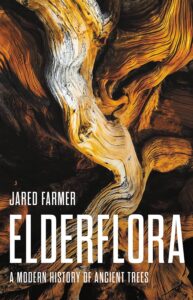Elderflora: A Modern History of Ancient Trees – Jared Farmer
 Elderflora: A Modern History of Ancient Trees. By Jared Farmer. (New York: Basic Books, 2022. pp. 482. Cloth, $35.00.)
Elderflora: A Modern History of Ancient Trees. By Jared Farmer. (New York: Basic Books, 2022. pp. 482. Cloth, $35.00.)
The history of elderflora, the name Jared Farmer gives to the longest lived trees on Earth, is the history not only of nature and the environment, but is also the history of human beings and their relationship to nature as individuals, as care-takers, and simply as co-evolving living beings. Elderflora is really Farmer’s investigation of how human-caused events are effecting elderflora through climate change. It is important to note that Farmer does take a global view of elderflora. While Farmer does take care to cite when certain trees are emblematic and intrinsic to Indigenous culture and identities, this is still a Eurocentric work. I think Farmer is following the scholarship and the history of the study of elderfora, which has been dominated by scientists in the West until very recently. But more work can be done on how native populations co-existed with and managed elderflora, and how they relate to them today. How do Indigenous Peoples view climate change?
One thing Farmer does bring to light is that the environment is always changing, it has been for billions of years, and can do so without human input on an everyday scale. That does not change, however, that human activities are now swiftly influencing the earth, introducing human-produced climate change. One thing Farmer seeks to understand is about how this climate change will effect the elderflora that have lived through thousands of years of change to serve as living testaments that can be compared to and measured against human history, in our own self-centered way. Humans and trees have been co-evolving for millennia.
I found one of Farmer’s most interesting chapters to be the one that chronicled how those who collected tree segments used a tree’s lifetime to measure the progress of human events. Samples taken from felled trees appeared in museums and private collections around the world and their custodians would display them with placards or strings aligned with certain rings that marked the occurrence of certain human events, for example, the fall of Rome. In this way human beings reinforced relationships to nature that measured the scale of its existence on a human timeline, putting forth that this nature only matters as it relates to events in human life. But these are imposed definitions. For Farmer, it is just as important that dendochronologists and other tree scientists use tree cores to track changes in the Earth’s environment over millennia. This can tell us how to understand evolution and the development of Earth’s environment, however, the focus always shifts back to humans, as the environmental history recorded by trees can help us understand our prospective future rocked by human-caused climate change.
Farmer relates a conversation he held with Doug Larson, “the scientist who documented Canada’s oldest trees, [and] started out as a lichenologist” (302). I found it extremely illuminating in terms of how scientists who study the deep past view nature and biology. The following exchange ensues:
I [Farmer] queried Larson: Are you moved by lichens? ‘Oh yeah,’ he replied immediately. ‘They’ve put up with far more [than trees]. You can have a nuclear war and they’ll do fine. Lichens and cockroaches – perfect food chain! When environmentalists says humans are going to destroy the Earth, that’s arrogant. There’s nothing that’s going to destroy the Earth. We might destroy ourselves; we might influence the food chain.’ (302)
Nature changes with our without us. And humans have long been doing things to change the Earth, at the expense of some species over others. But so has nature. If climate change continues, Earth might not be destroyed, in Larson’s terminology, but it will most likely look very different, and it could very likely be without us to see what a new Earth looks like. For Larson, we are just blips on the timeline. For Farmer, the existence of elderflora proves that humans and nature are inextricably connected, and to steward the health of one is to steward the health of the other. Trees can teach us as much about ourselves as they can about themselves.
I am not sure this is the message Farmer wants me to walk away with. So much of his story is about human’s discovery of the past, and how that is shaping our understanding of the future and more, how we might be able to use that knowledge to positively effect the future, to steer us away from a looming disaster. I believe the climate change is real, and I believe we must to something to stop it or alleviate its symptoms, that we are responsible for rehabilitating the nature we have so debilitated over the centuries. But this provokes a laundry list of questions. Who or what is worth saving? Is there actually ideal balanced nature that we can return to, or do we have to make sacrifices to save the parts that we deem worth saving? What do we do about the massive imbalance of environmental degradation between the developed and developing worlds? What should the future look like? Scientists, historians, politicians, and their constituents, no matter race, gender, or class, must work together to answer these questions. For Farmer, studying elderflora may help answer these questions. If we study the natural world and the history and stories it can tell us, we will learn about our own nature. And that is worth saving.
